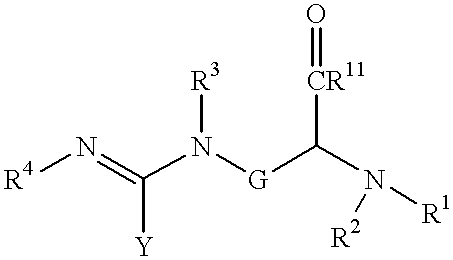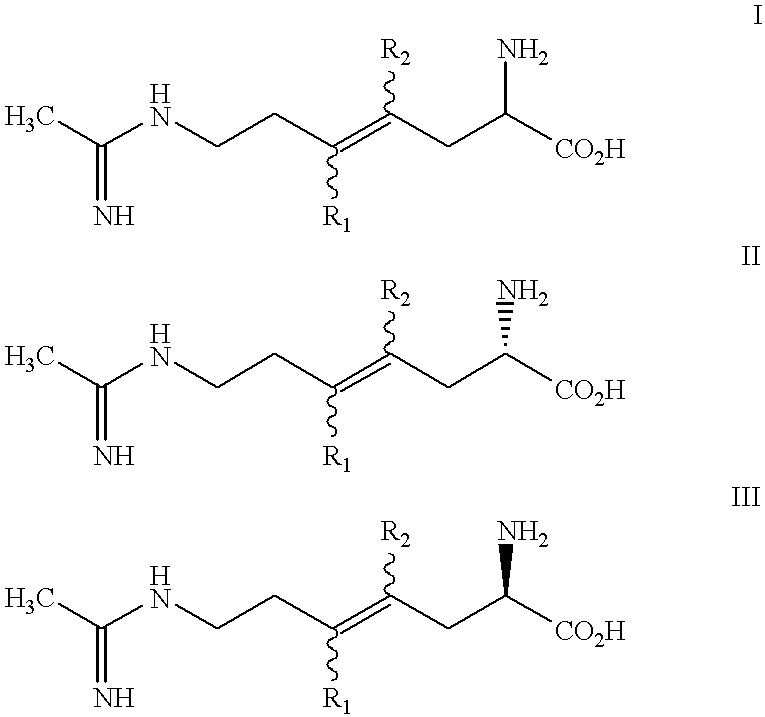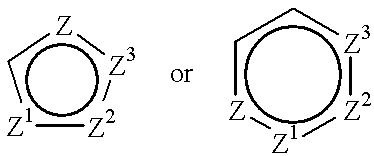Halogenated 2-amino-4, 5 heptenoic acid derivatives useful as nitric oxide synthase inhibitors
a technology of nitric oxide synthase and heptenoic acid, which is applied in the direction of peptide/protein ingredients, immunological disorders, metabolism disorders, etc., can solve the problem that imposing conformational rigidity with one or more carbon-carbon double bonds is not a favorable approach to impart selectivity to nos inhibitors
- Summary
- Abstract
- Description
- Claims
- Application Information
AI Technical Summary
Benefits of technology
Problems solved by technology
Method used
Image
Examples
example 2
(2S,4E)-2-Amino-5-Fluoro-6-(1-iminoethylamino)-hept-4-enoic acid
##STR18## ##STR19##
2a) 31.88 g (122 mmol) N.sup..alpha. -Boc-L-Asp(OMe).sub.2 was dissolved in the mixture of 100 mL THF and 10 mL methanol. The solution was cooled in an ice bath and it was treated with 9.45 g (250 mmol) NaBH.sub.4 with stirring for 2 hours. The reaction was quenched with the slow addition of 10 mL sat. KHSO.sub.4 and the solvent was evaporated in vacuo. The residue was dissolved in 200 mL sat. NaCl and extracted with 2.times.200 mL EtOAc, dried over MgSO.sub.4 and the solvent was evaporated in vacuo to yield 12.1 g (59 mmol; 48%) clear oil. FAB MS: MH.sup.+ =206.3 MNa.sup.+ =228.3 ##STR20##
2b) 14 g (68.3 mmol) dialcohol from step 2a was dissolved in 70 mL CH.sub.2 Cl.sub.2 and reacted with 14.56 g (17.2 mL; 140 mmol) 2,2-dimethoxypropane for 18 hours in the presence of 1.9 g (10 mmol) p-toluene sulphonic acid xH.sub.2 O. Then the solvent was evaporated in vacuo and the residue was dissolved in 300 mL ...
example 3
(2R / S, 4E / Z)-2-Amino-4,5-difluoro-6-(1-iminoethylamino)-hept-4-enoic acid
##STR28##
3a) To a solution of 3-methyl, 1,2,4-oxadiazolinone (prepared by the procedure of Tet. Let. 36(25), 4471-4474 (1995)) in acetone is added allyl bromide and potassium carbonate. This is stirred until complete by TLC. Isolation of the product by chromatography affords 3-methyl, 4-allyl, 1,2,4-oxadiazolinone.
3b) A solution of 3-methyl, 4-allyl, 1,2,4-oxadiazolinone is allowed to react with ozone, followed by workup conditions containing NaBH4. Isolation of the product afforded 3-methyl, 4-(2-hydroxyethyl), 1,2,4-oxadiazolinone.
3c) To a solution of 3-methyl, 4-(2-hydroxyethyl), 1,2,4-oxadiazolinone in methylene chloride is added triphenylphosphine and carbon tetrabromide. This is allowed to stir until complete by TLC. Isolation of the product affords 3-methyl, 4-(2-bromoethyl), 1,2,4-oxadiazolinone. ##STR29##
3d) To a solution of 3-methyl, 4-(2-bromoethyl), 1,2,4-oxadiazolinone in anhydrous THF at -78.degre...
example 4
(2R / S,4Z)-2-Amino-4,5-difluoro-6-(1-iminoethylamnino)-hept-4-enoic acid
##STR34##
4a) The Z isomer is isolated by chromatography from example 3g.
4) The product of step 4a is subjected to sonication in acetic acid / water in the presence of Zinc. This is followed by aqueous acid hydrolysis to afford the title product.
PUM
| Property | Measurement | Unit |
|---|---|---|
| pH | aaaaa | aaaaa |
| pH | aaaaa | aaaaa |
| pH | aaaaa | aaaaa |
Abstract
Description
Claims
Application Information
 Login to View More
Login to View More - R&D
- Intellectual Property
- Life Sciences
- Materials
- Tech Scout
- Unparalleled Data Quality
- Higher Quality Content
- 60% Fewer Hallucinations
Browse by: Latest US Patents, China's latest patents, Technical Efficacy Thesaurus, Application Domain, Technology Topic, Popular Technical Reports.
© 2025 PatSnap. All rights reserved.Legal|Privacy policy|Modern Slavery Act Transparency Statement|Sitemap|About US| Contact US: help@patsnap.com



